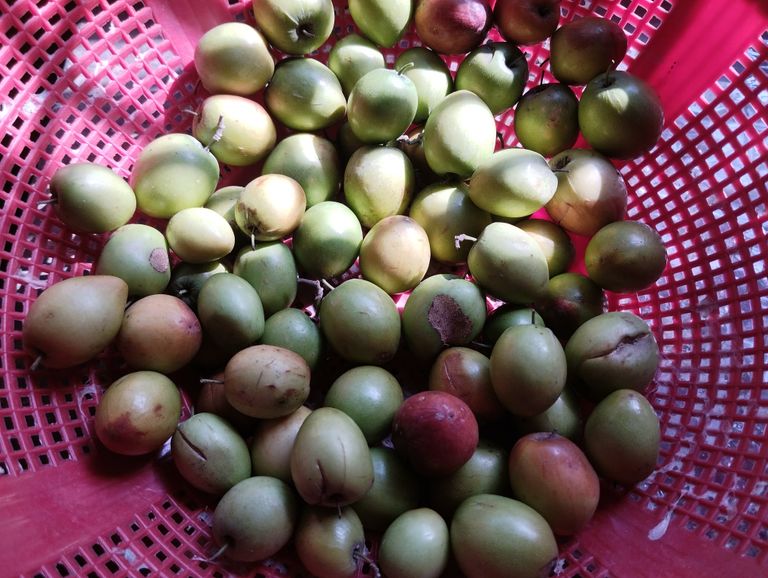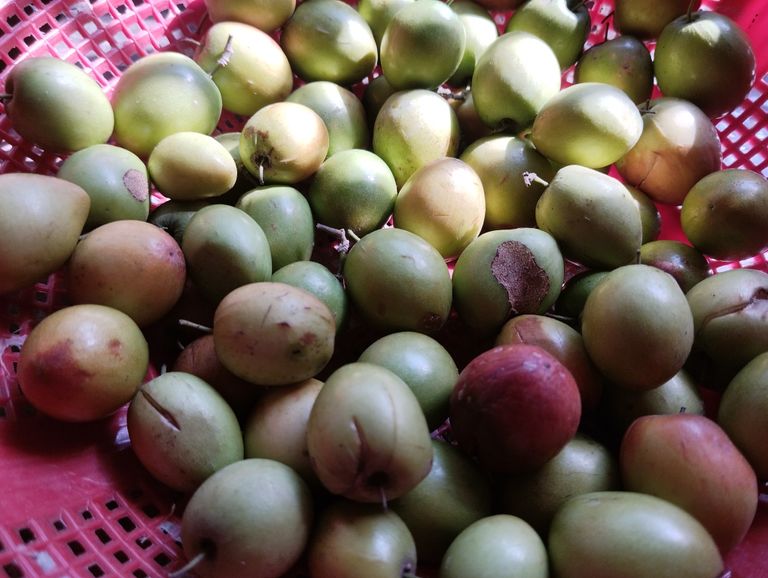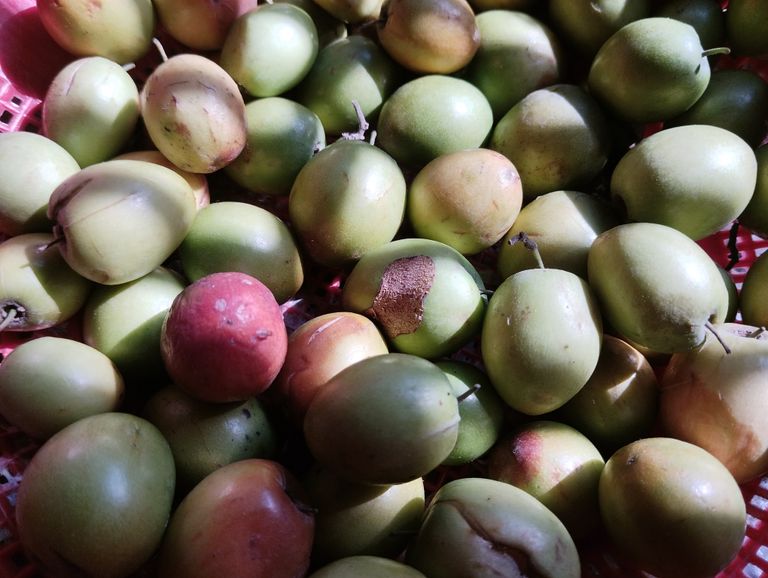
Health Benefits of Eating Ripe Jujube Boroi.
Jujube, commonly known as Boroi in Bangladesh, is a small, round fruit that comes in both fresh and dried forms. When ripe, it turns red or brown and becomes sweet and juicy. This nutrient-dense fruit has been used in traditional medicine for centuries due to its numerous health benefits. In this blog, we will explore the various health benefits of eating ripe jujube, its nutritional value, and how it can be incorporated into your diet.
Nutritional Value of Ripe Jujube
Ripe jujube is packed with essential nutrients that contribute to overall health. Here are some key nutrients found in ripe jujube:
Vitamin C – Boosts immunity and promotes healthy skin.
Vitamin A – Supports eye health and improves skin texture.
Antioxidants – Protects cells from damage and slows aging.
Iron – Helps in the production of red blood cells.
Potassium – Maintains heart health and regulates blood pressure.
Dietary Fiber – Aids digestion and promotes gut health.
Due to its rich nutrient profile, consuming ripe jujube regularly can offer numerous health benefits.
Health Benefits of Eating Ripe Jujube
- Boosts Immunity
Ripe jujube is an excellent source of vitamin C and antioxidants, which strengthen the immune system. Regular consumption of this fruit helps the body fight infections, colds, and flu.
- Improves Digestion
Jujube is rich in dietary fiber, which aids digestion by promoting healthy bowel movements and preventing constipation. It also helps maintain a balanced gut microbiome.
- Enhances Skin Health
The antioxidants and vitamin C in jujube help reduce signs of aging, such as wrinkles and fine lines. It also promotes collagen production, making the skin look youthful and radiant.
- Supports Heart Health
Jujube contains potassium, which helps regulate blood pressure and reduce the risk of heart disease. Additionally, it has compounds that lower cholesterol levels and improve circulation.
- Reduces Stress and Anxiety
Jujube has natural sedative properties that help calm the nervous system. It is often used in traditional medicine to treat insomnia, anxiety, and stress-related disorders.
- Strengthens Bones
The calcium and phosphorus in jujube contribute to stronger bones and help prevent osteoporosis, especially in older adults.
- Helps in Weight Management
Due to its low-calorie and high-fiber content, ripe jujube keeps you full for longer periods, reducing the chances of overeating. This makes it an excellent fruit for those trying to lose or maintain weight.
- Regulates Blood Sugar Levels
Jujube has a low glycemic index, meaning it does not cause sudden spikes in blood sugar levels. This makes it a suitable fruit for diabetics when consumed in moderation.
- Supports Brain Health
The antioxidants in jujube help protect brain cells from damage and improve cognitive function. Some studies suggest that it may also help prevent neurodegenerative diseases like Alzheimer’s.
- Aids in Detoxification
Jujube helps cleanse the liver by eliminating toxins from the body. It improves liver function and overall detoxification processes.
How to Eat Ripe Jujube
There are many delicious ways to enjoy ripe jujube:
Eat fresh as a snack.
Add to fruit salads for extra sweetness.
Blend into smoothies for a natural energy boost.
Use in desserts like jujube jam or jujube cakes.
Dry the fruit and eat as a healthy snack.
Precautions and Side Effects
While jujube is generally safe to eat, here are a few precautions to keep in mind:
Overconsumption may cause bloating or digestive issues due to its high fiber content.
Diabetics should consume it in moderation to avoid blood sugar fluctuations.
Allergic reactions are rare but possible, so be cautious if trying jujube for the first time.
Ripe jujube (Boroi) is a powerhouse of nutrients and offers numerous health benefits, including boosting immunity, improving digestion, enhancing skin health, and promoting heart health. Incorporating this delicious fruit into your daily diet can help you stay healthy and energized. Enjoy ripe jujube in various ways and make the most of its incredible health benefits Do you love eating ripe jujube? Share your favorite way to enjoy this fruit in the comments.

Boroi (Jujube) Cultivation: A Complete Guide
Boroi, also known as jujube or Indian plum (Ziziphus mauritiana), is a highly nutritious and commercially profitable fruit grown in tropical and subtropical regions. This fruit is widely cultivated in countries like India, Bangladesh, China, and Thailand due to its adaptability, high yield, and market demand. In this blog, we will provide a comprehensive guide to boroi cultivation, including climate requirements, soil preparation, planting techniques, irrigation, pest management, and harvesting.
- Climate and Soil Requirements
Climate
Boroi grows well in tropical and subtropical climates with moderate rainfall. It is a drought-tolerant fruit and can survive in arid conditions. However, excessive moisture and frost can damage the plant. The ideal temperature for boroi cultivation ranges between 25°C to 35°C.
Soil
Boroi can grow in a variety of soils, but well-drained loamy or sandy-loam soil is best for high yield. The pH level of the soil should be between 5.5 to 7.5. Avoid waterlogged or highly alkaline soils, as they can hinder plant growth.
- Best Varieties of Boroi
There are several improved varieties of boroi that are cultivated for better yield and fruit quality. Some of the best varieties include:
BAU Kul – A high-yielding variety with large, sweet fruits.
Apple Kul – Popular for its large, crispy, apple-like texture.
Bau Kul-2 – A commercial variety with high disease resistance.
Narikel Kul – Round-shaped variety with coconut-like texture.
Thai Kul – Large and juicy fruits with a sweet taste.
- Land Preparation and Planting Method
Land Preparation
Before planting boroi, the field should be properly prepared by plowing and leveling. Add organic manure (cow dung or compost) at a rate of 10–12 tons per hectare to improve soil fertility.
Planting Time
The best time for planting boroi is June to August in rainy areas and September to October in dry regions.
Planting Method
Dig pits of 60 cm × 60 cm × 60 cm at a spacing of 4m × 4m for normal varieties and 5m × 5m for spreading varieties.
Mix topsoil with organic manure, superphosphate (250g), and potash (150g) before filling the pits.
Place the plant in the pit and gently cover the roots with soil.
Water immediately after planting.
- Fertilizer Management
To ensure healthy plant growth and high yield, proper fertilization is necessary. The recommended fertilizers per plant are:
Fertilizers should be applied three times a year: once in June, once in September, and again in December.
- Irrigation and Water Management
Boroi trees require regular irrigation during dry periods, especially after flowering and fruit setting. However, overwatering should be avoided as it can cause root rot. The irrigation schedule depends on soil moisture levels:
Summer (March-May): Water every 7–10 days.
Winter (November-February): Water every 15–20 days.
Rainy season: No irrigation is required.
- Pruning and Training
Regular pruning is essential to maintain tree shape, improve air circulation, and enhance fruit production.
First-year pruning: Remove weak branches and maintain a single strong trunk.
Annual pruning: Cut diseased, dry, or overcrowded branches.
Post-harvest pruning: Trim excess branches to encourage new growth.
- Pest and Disease Management
Common Pests
- Fruit Fly: Causes fruit dropping and rotting.
Control: Use pheromone traps and spray neem extract.
- Borers: Attack stems and branches, weakening the tree.
Control: Apply Chlorpyrifos 2ml/L of water.
- Aphids: Suck sap from leaves, causing curling and yellowing.
Control: Use Neem oil spray or Imidacloprid 0.5ml/L.
Common Diseases
- Powdery Mildew: Causes white powdery coating on leaves.
Control: Spray Sulfur fungicide (2g/L water).
- Leaf Spot: Brown or black spots appear on leaves.
Control: Apply Copper Oxychloride (3g/L water).
- Dieback Disease: Causes branch drying and leaf drop.
Control: Prune affected branches and use Carbendazim 1g/L.
- Flowering and Fruit Development
Boroi trees start flowering in October-November, and fruits develop from December to March. The flowers attract pollinators like bees, which help in fruit setting. Proper nutrient management and irrigation during this stage ensure good-quality fruit.
- Harvesting and Yield
Harvesting Time
Boroi is ready for harvest 90–120 days after flowering. The fruits should be picked when they reach full size and color. Avoid overripe fruits as they have a shorter shelf life.
Harvesting Method
Handpicking is the best method to avoid damage.
Harvest in the morning or evening for better fruit freshness.
Expected Yield
The yield depends on the variety and management:
1st Year: 10–15 kg per tree
2nd Year: 20–30 kg per tree
3rd Year & Above: 50–100 kg per tree
- Post-Harvest Management and Marketing
After harvesting, boroi should be:
Cleaned properly to remove dirt.
Sorted and graded based on size and quality.
Packed in baskets or cartons for transportation.
Marketing
Boroi has a high demand in local and export markets. Farmers can sell fresh fruits in:
Local markets and supermarkets.
Processing units for making dried boroi, pickles, or jams.
Export markets for higher profits.
Boroi cultivation is a profitable agribusiness with low maintenance and high returns. With proper land preparation, irrigation, pruning, and pest management, farmers can achieve a high yield. Additionally, processing boroi into value-added products can further enhance income. If you are planning to start boroi farming, following the above steps will ensure success in your orchard. Are you interested in boroi farming? Let us know in the comments.

Boroi Diseases: Causes, Symptoms, and Management
Boroi (Ziziphus mauritiana), also known as Indian jujube or Chinese date, is a popular fruit in many tropical and subtropical regions. This fruit is cherished for its sweet-tart taste, high nutritional value, and medicinal properties. However, boroi plants are susceptible to various diseases that can affect fruit production and quality. In this blog, we will explore common diseases affecting boroi, their symptoms, causes, and management strategies.
Common Diseases of Boroi and Their Management
- Powdery Mildew (Oidium sp.)
Symptoms:
White, powdery fungal growth on leaves, young shoots, and fruits.
Leaves may curl and become deformed.
Affected fruits may crack and develop blemishes, reducing market value.
Causes:
Caused by the fungus Oidium sp.
Spread through wind and infected plant debris.
More prevalent in dry and warm conditions with high humidity.
Management:
Remove and destroy infected plant parts.
Apply sulfur-based fungicides or neem oil as preventive measures.
Maintain proper spacing between plants to ensure good air circulation.
Avoid excessive nitrogen fertilizer, which encourages tender growth susceptible to infection.
- Anthracnose (Colletotrichum sp.)
Symptoms:
Dark brown or black spots on leaves and fruits.
Infected fruits develop sunken lesions, often with pinkish fungal spores.
Leaves may drop prematurely, affecting overall tree health.
Causes:
Caused by the fungal pathogen Colletotrichum sp.
Thrives in warm, humid conditions.
Spread through rain splashes, insects, and contaminated tools.
Management:
Prune infected branches and dispose of them properly.
Use copper-based fungicides or organic alternatives like Bordeaux mixture.
Avoid overhead irrigation to minimize moisture on leaves.
Rotate crops and maintain field hygiene to reduce fungal buildup.
- Fruit Rot (Phomopsis sp., Alternaria sp.)
Symptoms:
Soft, watery, or dark rotting patches on fruits.
Fungal growth on fruit surfaces, often accompanied by a foul smell.
Premature fruit drop and poor fruit quality.
Causes:
Fungal pathogens such as Phomopsis and Alternaria species.
Excess moisture, poor drainage, and infected plant debris.
Spread through wind, water, and insects.
Management:
Improve field drainage to avoid waterlogging.
Harvest fruits at the right stage to prevent post-harvest infections.
Apply biofungicides like Trichoderma or chemical fungicides if necessary.
Store harvested fruits in cool, dry conditions to minimize spoilage.
- Bacterial Leaf Spot (Xanthomonas sp.)
Symptoms:
Small, water-soaked lesions on leaves that turn brown or black.
Infected leaves may have yellow halos around the spots.
Severe infections can cause leaf drop and stunted growth.
Causes:
Caused by the bacterium Xanthomonas species.
Spread through rain splashes, infected seeds, and contaminated tools.
More common in warm, humid conditions.
Management:
Use disease-free planting materials.
Avoid overhead watering to reduce leaf wetness.
Spray copper-based bactericides or organic alternatives like garlic extract.
Remove and destroy infected leaves to prevent further spread.
- Root Rot (Phytophthora sp.)
Symptoms:
Yellowing and wilting of leaves.
Roots become soft, dark, and decayed.
Stunted growth and reduced fruit yield.
Causes:
Caused by the fungus Phytophthora sp.
Common in waterlogged soils and poorly drained fields.
Spread through contaminated soil, water, and infected plant debris.
Management:
Improve soil drainage and avoid overwatering.
Apply organic matter to enhance soil health and microbial balance.
Use fungicides like metalaxyl or biofungicides like Trichoderma.
Rotate crops and avoid planting boroi in previously infected areas.
General Preventive Measures for Boroi Diseases
Proper Pruning: Regular pruning improves air circulation and reduces disease incidence.
Sanitation: Remove fallen leaves and infected plant parts to prevent the spread of pathogens.
Balanced Fertilization: Avoid excessive nitrogen, which makes plants more vulnerable to diseases.
Irrigation Management: Water at the base of the plant to avoid wetting the leaves.
Use of Resistant Varieties: Select disease-resistant or tolerant varieties for better yield.
Organic Treatments: Neem oil, garlic extract, and biofungicides can help prevent infections.
Conclusion
Boroi cultivation can be highly profitable, but disease management is crucial for a healthy and productive orchard. By identifying diseases early and implementing effective control measures, farmers can ensure better fruit quality and yield. Using a combination of cultural, biological, and chemical methods will help protect boroi plants and maintain sustainable farming practices.
If you are growing boroi and facing disease issues, consider applying these management strategies for a healthier crop!
Would you like me to add more details or suggest organic disease control methods? Let me know how I can improve the blog.

Boroi Diseases: Causes, Symptoms, and Management
Boroi (Ziziphus mauritiana), also known as Indian jujube or Chinese date, is a popular fruit in many tropical and subtropical regions. This fruit is cherished for its sweet-tart taste, high nutritional value, and medicinal properties. However, boroi plants are susceptible to various diseases that can affect fruit production and quality. In this blog, we will explore common diseases affecting boroi, their symptoms, causes, and management strategies.
Common Diseases of Boroi and Their Management
- Powdery Mildew (Oidium sp.)
Symptoms:
White, powdery fungal growth on leaves, young shoots, and fruits.
Leaves may curl and become deformed.
Affected fruits may crack and develop blemishes, reducing market value.
Causes:
Caused by the fungus Oidium sp.
Spread through wind and infected plant debris.
More prevalent in dry and warm conditions with high humidity.
Management:
Remove and destroy infected plant parts.
Apply sulfur-based fungicides or neem oil as preventive measures.
Maintain proper spacing between plants to ensure good air circulation.
Avoid excessive nitrogen fertilizer, which encourages tender growth susceptible to infection.
- Anthracnose (Colletotrichum sp.)
Symptoms:
Dark brown or black spots on leaves and fruits.
Infected fruits develop sunken lesions, often with pinkish fungal spores.
Leaves may drop prematurely, affecting overall tree health.
Causes:
Caused by the fungal pathogen Colletotrichum sp.
Thrives in warm, humid conditions.
Spread through rain splashes, insects, and contaminated tools.
Management:
Prune infected branches and dispose of them properly.
Use copper-based fungicides or organic alternatives like Bordeaux mixture.
Avoid overhead irrigation to minimize moisture on leaves.
Rotate crops and maintain field hygiene to reduce fungal buildup.
- Fruit Rot (Phomopsis sp., Alternaria sp.)
Symptoms:
Soft, watery, or dark rotting patches on fruits.
Fungal growth on fruit surfaces, often accompanied by a foul smell.
Premature fruit drop and poor fruit quality.
Causes:
Fungal pathogens such as Phomopsis and Alternaria species.
Excess moisture, poor drainage, and infected plant debris.
Spread through wind, water, and insects.
Management:
Improve field drainage to avoid waterlogging.
Harvest fruits at the right stage to prevent post-harvest infections.
Apply biofungicides like Trichoderma or chemical fungicides if necessary.
Store harvested fruits in cool, dry conditions to minimize spoilage.
- Bacterial Leaf Spot (Xanthomonas sp.)